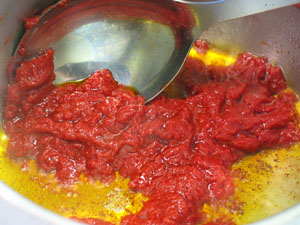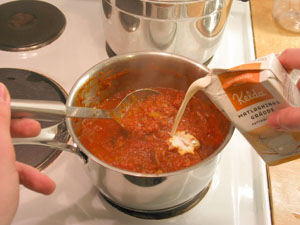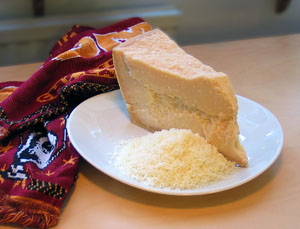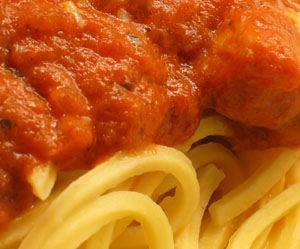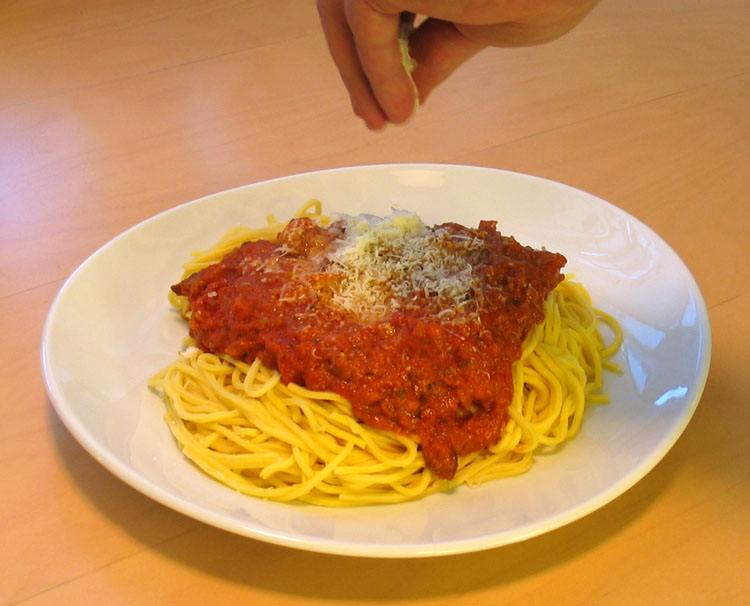The ultimate tomato sauce
Why tomato sauce? The answer is, of course, that a sauce of tomatoes is delicious, healthy and inexpensive, and it is entirely vegetarian. Tomato sauce is best matched by a nice pasta, but can also be used in other dishes. Unfortunately, the favourable properties of tomato sauce are often ruined by insufficient competence of the cook. With this page, we, Alexis Brandeker and Carl Granath, want to share the knowledge we have accumulated during several decades of hundreds of tomato sauce experiments.
The wrong way
There are several ways of cooking a tasty tomato sauce, and unfortunately some ways of making it terrible. The most common errors found in inferior tomato sauces are:
If you only avoid the above traps, it is difficult to fail in cooking a nice tomato sauce.
Basic recipe
Below follows a basic recipe of a delicious tomato sauce, and some variants on it. The recipes are based on our own experiments and development of an original recipe from Aliki Brandeker. In our experience, there is no better tomato sauce than that cooked according to the recipe below. If you have found one, or just know a really good variant, please communicate your knowledge to alexis@astro.su.se.
Ingredients for 2 persons (about 6 portions)
The measures are approximate by nature, and given as guidelines.
Detailed description
Open the cans of tomato. Pour the olive oil into a saucepan (of about 3 litre volume), making the oil completely cover the bottom. Push out half the tube of concentrated tomato into the pan, heat it up, and fry the tomatoes until they almost get burned and stick to the pan. This is important to give the sauce a slightly "burned", strong tomato taste. Set the plate to low heat, and pour in the chopped tomatoes and 2 dl of water. The water may be used to rinse out the tomato cans, to limit the amount of precious tomato getting lost. Cover the pan with a lid, and let the tomatoes simmer at their own pace. Chop the onion and garlic finely, the finer the better (down to pieces of 2-3 mm). Pour in the chopped onion and garlic, dash in the cinnamon and clove, and crumble in the stock cubes. Let the sauce boil on low heat for at least 30 minutes, preferably 45 minutes or more. There is no upper limit, more than that the water must not boil away completely, burning the sauce. After 45 minutes the tomato sauce has underwent a phase transition and changed its taste significantly. The onion and garlic have softened and mixed up their tastes with the tomatoes and the spices. Now add, just at the end, the basil and the cream, and let the sauce stay a few minutes on the afterheat of the switched off plate. By adding the basil at the end, one avoids boiling it to pieces and keeps its freshness. The sauce is now ready to be served.
Variants
The basic recipe may advantageously be varied after mood. If a spicier sauce is desired, add some variant of sambal during the frying of the concentrated tomatoes. The heat takes away some of the afterburning chilli heat, while the direct chilli heat is kept.
A more filling sauce is accomplished by adding butter-fried mushrooms. Chop the mushrooms (or some other fungi) in centimetre thick pieces a fry them in butter at high temperature until they get colour and almost burned. To avoid contaminating the tomato sauce with too much mushroom taste, add them at the end together with the basil.
By replacing the water with red wine, a richer sauce is obtained. The addition of cream then becomes unnecessary, even if the combination wine/cream still is OK. Pour in half of the wine together with the chopped tomatoes at the beginning, and the rest a couple of minutes from the end. In this way a full body wine taste is accomplished with just the right alcohol character. Our tomato sauce results have not been sensitively dependent on the type of red wine. We have mostly used Rioja-wines.
Instead of canned tomatoes, peeled, chopped, fresh tomatoes may be used. One can also fry the fresh tomatoes at high temperature in a regular frying pan instead of a sauce pan, which gives a nice concentrated tomato taste á la sun-dried tomatoes.
Simplified description:
On ingredients
We have tried a large range of different raw products and come to the following conclusions. The difference among canned chopped tomatoes brands is small, they all taste about equally good. Beware, though, of canned tomatoes containing something else than tomatoes, like basil, sugar, vinegar, or something else suspicious. Fortunately they are very rare in Sweden, but in other countries (like Spain! Do not ever use canned tomatoes labelled "tomates fritos", they are not fit for human consumption) they are fairly common. Concentrated tomatoes, called tomatpuré in Swedish, can be difficult to get hold of. We recommend the Italian brand Ardita, which consistently maintains high quality. The onion should not be too fresh, which may give a slightly sour taste to the sauce. Garlic is one of the most difficult ingredients to classify before consumption, because of the wide variety of species of very different strengths and tastes. Fresh garlic works very well in the tomato sauce, but is difficult to keep more than just a few days. Chinese garlic has the advantage of being a single clove. Dried basil has very different properties compared to fresh or frozen, and should not be used in a tomato sauce. Rather than using dried basil, it is better to avoid basil altogether.
